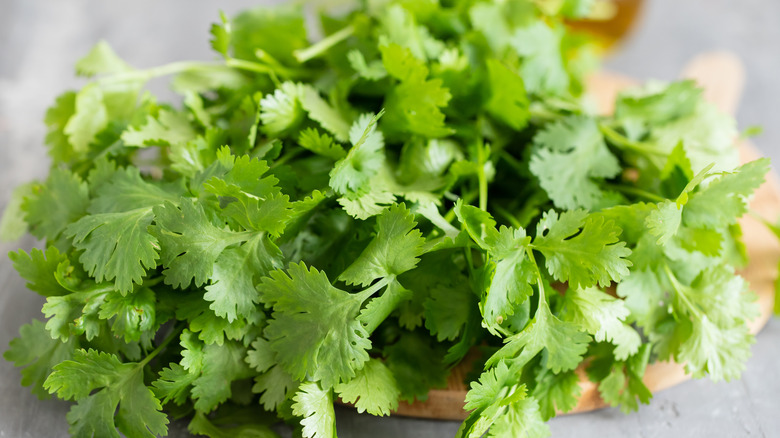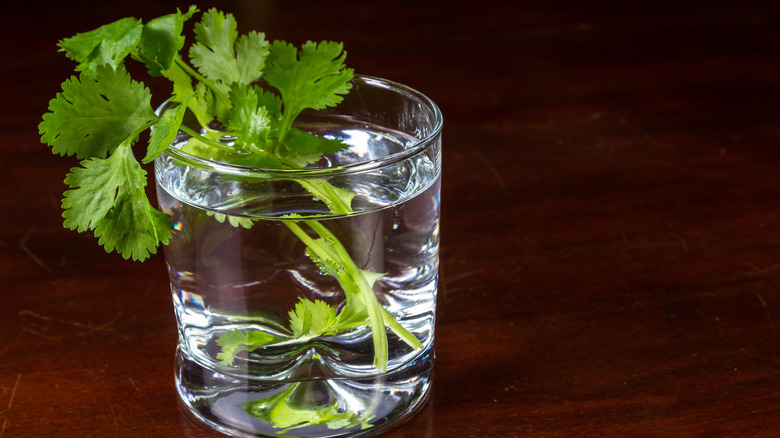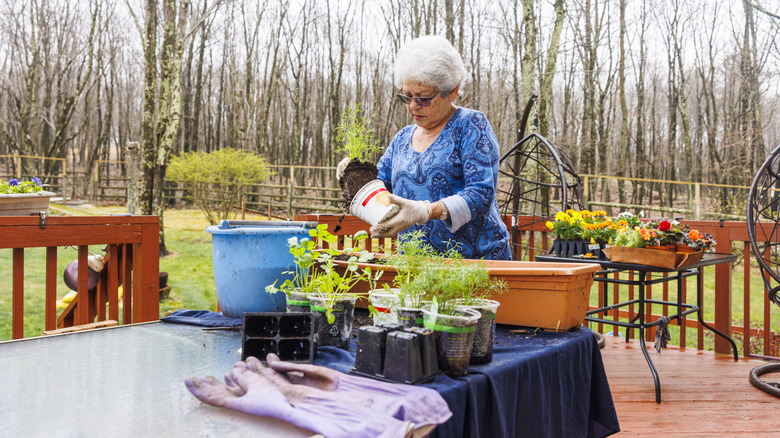Can You Regrow Store-Bought Cilantro To Bring More Magic To Your Herb Garden?
Whether you want to add color and flavor to salsa, or you need the perfect finishing touch for a delicious curry, cilantro is the secret weapon to achieve victory on your culinary quest. Imagine your disappointment, then, when you open your refrigerator to find the crispy fresh herb you bought reduced to a sad, droopy, and brown bag of mush. And even though there are many hacks and tricks to store your cilantro to make it last longer (and of course, you can always buy more at the store), it's a bit more fun to learn how to grow and care for your own cilantro in your herb garden.
While there has been great debate among gardeners as to the success of re-growing store-bought cilantro, the good news for that herb sitting in your refrigerator (presumably scared of landing in the trash can) is that you actually can regrow store-bought cilantro from cuttings of healthy stems. After that, you can later repot into a larger container, or plant it out in your garden where it can thrive with your other homegrown herbs. Here's how to get started.
How to propagate your cilantro from cuttings
While the most reliable route to success is to grow your cilantro from seeds, if you have a few fresh stems at home, it could be worth trying to grow your cilantro from cuttings. You need to pick out the healthiest-looking stems from the bunch: try to find some that are about 3-5 inches long. Cut them below the node and place the ends in a glass of plain water. Equally important as picking the best stems for your plant is picking the right location. In warmer climates, place your stems in a room with bright, indirect light so they can maintain a good temperature without getting too cold.
Once your cilantro's roots are established, gently transfer them to a pot where they can get the nutrients they need. When transferring your cilantro, you want to provide it with the best environment for it to thrive by planting it in rich, well-draining soil with compost and quality potting mix. When planting in containers, always ensure they have good drainage to avoid waterlogging. You also have the option to reuse empty food container as seed starters since these are eco-friendly and will help to reduce waste.
A few things to keep in mind when growing cilantro
Cilantro grown from cuttings doesn't always produce roots, so you might want to manage your expectations before trying this at home. Once your roots are at least one inch long, though, support your herb's growth by applying a nitrogen-rich fertilizer or another water-soluble plant food to the soil every other week. Try not to be too heavy handed with your fertilizer though, as this can cause your cilantro to lose some of that great flavor which made you want to grow it in the first place. What's more, excess fertilizer can further attract pests like aphids and cabbage looper. With the added risk of propagating your cilantro from cuttings, you don't want to add pests and diseases like leaf spot, yellow botch, and crown rot to your list of worries. For that, make sure your plant is located where it can get full sun; it can tolerate minimal shade in warmer climates, but try not to overdo it.
However, you will need to be mindful of too much heat in warmer climates. Too much heat could cause your cilantro to start bolting – that is, when it prematurely starts producing flowers, reducing the flavor in the leaves. You can avoid this by plucking out your cilantro leaves for dinners as soon as you see they're the right size. If you've planted your herbs outside, you could also build a spiral herb garden to create the ideal microclimate for each of your herbs and cater to their various sun, shade, moisture, and drainage needs.


